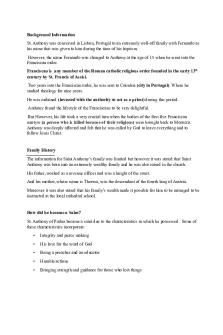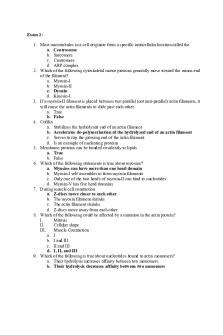Group Worksheet 1- Anthony Arredondo PDF

| Title | Group Worksheet 1- Anthony Arredondo |
|---|---|
| Author | Anthony Arredondo |
| Course | Biological Evolution |
| Institution | The University of Texas Rio Grande Valley |
| Pages | 3 |
| File Size | 185.4 KB |
| File Type | |
| Total Downloads | 77 |
| Total Views | 125 |
Summary
Download Group Worksheet 1- Anthony Arredondo PDF
Description
Group Worksheet #1
Name(s): Anthony Arredondo (I.D.- 20406043)
1. A paleontological research group is studying fossil deposit from an ancient inland sea. The diagram below represents the location of various fossil specimens of two extinct species: a fish and a turtle. Use your understanding of stratigraphy and relative dating to answer the following questions. a. Why were no fossils discovered in rock layer D? Layer D is igneous rock which is difficult for fossils to form due to that igneous rocks are cooled lava. When igneous is warm it burns everything in its way. b. Which of the sedimentary rock layers is the most ancient and how do you know? Sedimentary Layer C is the oldest because it is located at the bottom of all the other layers. c. A brand new trainee is unsure which rock layer was the most important to date so he ships a sample of each of the four layers (A, B, C, and D) for direct radioactive dating with results as follows: A: 15 mya, B: 60 mya, C: 10 mya, D: 25 mya When did the fish species go extinct? Sometime from 25 m.y.a and older When did the turtle species go extinct? Sometime between 0 and 25 m.y.a d. A member of the research group finds a non-fossilized organic sample in the soil above the rock layers, what would be the best approach to get an accurate date for this material and what are the limitations of this approach? By using carbon dating to try and determine the age of the organic material, as well as dating the surrounding soil or rocks. When the age of the sample is discovered it is just a frame of the time which make the result inaccurate.
2. What is the ultimate source of all the energy that powers your cells (and > 99.9% of all life on earth)? Chemosynthesis a. When did this process evolve and how do we know? 3.5 b.y.a b. When did appreciable levels of oxygen (O2) begin to build up in the atmosphere? 2.5 b.y.a c. Why was there such a long delay between the dates in part 2a and 2b above? The reason for a large delay is because fossils were being oxidized by cyahobateria which use the process of photosynthesis to produce a waste product of oxygen.
3. Using what you know about the organisms below (and/or the trusty internet) create a matrix of six binary characters that could be helpful in understanding the phylogenetic relationships of these organism. Code the character states in the matrix below. Character 1: External Eggs Character 2: Feathers Character 3: Bipedal Character 4: Carnivores Character 5: Produce milk or any form of milk for young Character 6: Have some form of webbing Ch 1:
Chicken Platypus Kangaroo Cat Sea Lion
Ch 2:
1 1 0 0 0
Ch 3:
1 0 0 0 0
Ch 4:
1 0 1 0 0
Ch 5:
0 1 0 1 1
Ch 6:
0 1 1 1 1
1 1 1 1 1
4. Map your characters onto the two phylogenies below. Using a parsimony criterion which phylogeny is the best hypothesis about the relationships among these organisms? Why? a. The first phylogeny best hypothesis the relationships with the organisms above due to the fact that it presence a hypothesis that some traits evolved at one single point in time rather than the trait being evolved two at separate points in times .
5. List a physical feature that is a synapomorphy for the group Mammalia. Hair or fur Mammary glands Four chambered heart 6. List a physical feature that is a symplesiomorphy for the group Mammalia. Amniotic egg Walk on four legs 7. Symplesiomorphy and _Synapomorph__ are sources of homoplasy....
Similar Free PDFs

Functional group worksheet
- 4 Pages

TRA & TPB Group Worksheet.
- 2 Pages

Anthony Gms 805 - Assignment 1
- 4 Pages

Capitulo 1-Anthony Giddens Resumen
- 16 Pages

Group 1 Mo M ( Group 1 PBI1082)
- 4 Pages

Anthony Hopkins - leer
- 3 Pages

Worksheet#7(1) - worksheet
- 3 Pages

Assignment 1 group 1
- 6 Pages

Saint Anthony of Padua
- 2 Pages
Popular Institutions
- Tinajero National High School - Annex
- Politeknik Caltex Riau
- Yokohama City University
- SGT University
- University of Al-Qadisiyah
- Divine Word College of Vigan
- Techniek College Rotterdam
- Universidade de Santiago
- Universiti Teknologi MARA Cawangan Johor Kampus Pasir Gudang
- Poltekkes Kemenkes Yogyakarta
- Baguio City National High School
- Colegio san marcos
- preparatoria uno
- Centro de Bachillerato Tecnológico Industrial y de Servicios No. 107
- Dalian Maritime University
- Quang Trung Secondary School
- Colegio Tecnológico en Informática
- Corporación Regional de Educación Superior
- Grupo CEDVA
- Dar Al Uloom University
- Centro de Estudios Preuniversitarios de la Universidad Nacional de Ingeniería
- 上智大学
- Aakash International School, Nuna Majara
- San Felipe Neri Catholic School
- Kang Chiao International School - New Taipei City
- Misamis Occidental National High School
- Institución Educativa Escuela Normal Juan Ladrilleros
- Kolehiyo ng Pantukan
- Batanes State College
- Instituto Continental
- Sekolah Menengah Kejuruan Kesehatan Kaltara (Tarakan)
- Colegio de La Inmaculada Concepcion - Cebu






